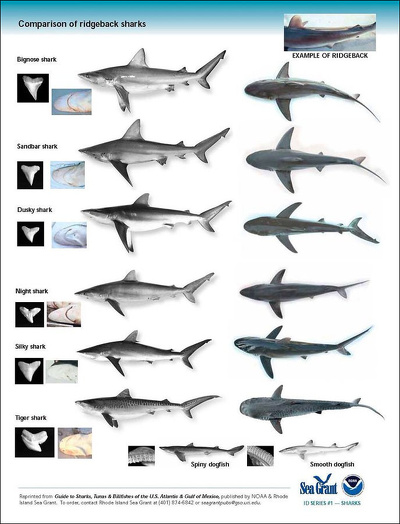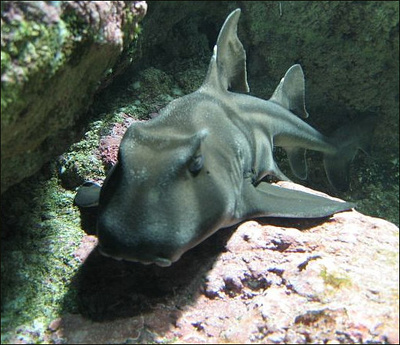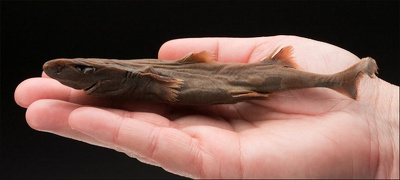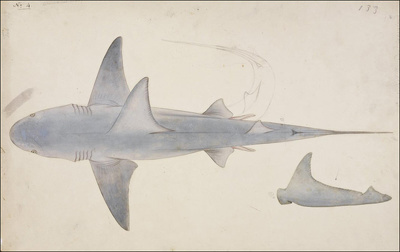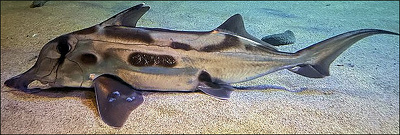Home | Category: Shark Species
SPECIES OF SHARKS
There are 538 species of shark. Only 13 species have bitten humans 10 or more confirmed times. Another two dozen or so species have bitten humans less than ten times. Most of the bites by these species were relatively minor.
There are 1,200 species in the class Chondrichthyans (Cartilaginous fishes), which embraces sharks, rays and chimaeras. Shark species range in size from 15-centimeter (six-inch) dwarf lantern sharks and 20-centimeter (8-inch) -long pygmy ribbontail catfish sharks, dwarf dog-sharks, and 30-centimeter (12) inch squaloid sharks to 18.8-meter (62-foot) -long, 40 ton whale sharks.
Different shark species often have different number of vertebrae. Shark scientists often use vertebrae counts to distinguish among species. Some shark species are difficult to tell from similar species. This is especially true with requiem shark, a group involved in some human shark bites. Some shark species are very well camouflaged. The chain catshark’s murky mottling mirrors shifting patterns of dark and light on the ocean floor. Splitfins shimmer like sunlight on water.
The shortfin mako shark is the fastest known shark. It can swim at 50 km/h (31 mph) and reach speeds of up to 46 mph (74 km/h) for short bursts, according to the Smithsonian. The longest-lived shark is also the longest-living vertebrate (all mammals, birds, reptiles, amphibians and fish). Greenland sharks have long been known to live for a really time. 2016 research that dated the layers in the sharks' eye lenses found that the sharks were between 272 and 512 years old. See Separate Articles on Mako Sharks and Greenland Sharks. [See Source: Stephanie Pappas, Live Science, July 25, 2022]
Related Articles:
COPPER SHARKS (BRONZE WAILERS): CHARACTERISTICS, BEHAVIOR AND REPRODUCTION ioa.factsanddetails.com
TIGER SHARKS: CHARACTERISTICS, BEHAVIOR, FEEDING AND MATING ioa.factsanddetails.com
TIGER SHARK ATTACKS ioa.factsanddetails.com
BULL SHARKS: CHARACTERISTICS, BEHAVIOR, FEEDING AND MATING ioa.factsanddetails.com
BULL SHARK ATTACKS ioa.factsanddetails.com ;
WHALE SHARKS: SIZE, CHARACTERISTICS, FEEDING HABITS, MATING ioa.factsanddetails.com ;
WHALE SHARKS AND HUMANS: TOURISM, CONSERVATION AND RESEARCH ioa.factsanddetails.com ;
BLACKTIP AND WHITETIP REEF SHARKS ioa.factsanddetails.com;
GREY REEF SHARKS
ioa.factsanddetails.com;
NURSE SHARKS: CHARACTERISTICS, BEHAVIOR, FEEDING, MATING, ATTACKS ioa.factsanddetails.com;
GREAT WHITE SHARKS: CHARACTERISTICS, SIZE, BODY AND SPEED ioa.factsanddetails.com ;
GREAT WHITE SHARK BEHAVIOR, SENSES, MATING AND SOCIAL ACTIVITY ioa.factsanddetails.com ;
GREAT WHITE SHARKS FEEDING, HUNTING AND PREY ioa.factsanddetails.com ;
GREAT WHITE SHARK MIGRATIONS AND WHERE THEY LIVE ioa.factsanddetails.com ;
SHARKS AND RAYS ioa.factsanddetails.com;
HUMANS, SHARKS AND SHARK ATTACKS ioa.factsanddetails.com;
SHARKS: CHARACTERISTICS, SENSES AND MOVEMENT ioa.factsanddetails.com ;
SHARK BEHAVIOR: INTELLIGENCE, SLEEP AND WHERE THEY HANG OUT ioa.factsanddetails.com ;
SHARK SEX: REPRODUCTION, DOUBLE PENISES, HYBRIDS AND VIRGIN BIRTH ioa.factsanddetails.com ;
SHARK FEEDING: PREY, HUNTING TECHNIQUES AND FRENZIES ioa.factsanddetails.com
HISTORY OF SHARKS: EARLIEST ONES. DINOSAUR-ERA ONES AND MEGALODON ioa.factsanddetails.com
Websites and Resources: Shark Foundation shark.swiss ; International Shark Attack Files, Florida Museum of Natural History, University of Florida floridamuseum.ufl.edu/shark-attacks ; Tracking Sharks trackingsharks.com, which records all global shark attacks; Animal Diversity Web (ADW) animaldiversity.org; National Oceanic and Atmospheric Administration (NOAA) noaa.gov; Fishbase fishbase.se ; Encyclopedia of Life eol.org ; Smithsonian Oceans Portal ocean.si.edu/ocean-life-ecosystems
Small Sharks Versus Large Sharks
Less than half of all sharks species reach lengths of three feet while the three largest species of shark — the whale shark, the basking shark and the relatively recently discovered "megamouth" are plankton feeders. Megamouth was first discovered after it accidentally swallowed an anchor. [Source: Eugenie Clark, National Geographic August 1981]
Small sharks — ones that are two meters or less in size — typically eat relatively small prey like small fish, shrimp, rays and octopus and don't normally go after large prey items. George Burgess, shark researcher and curator of the International Shark Attack File at the Florida Museum of Natural History, told the Huffington Post the “teeth are not designed evolutionarily for tearing, but rather for grabbing and swallowing whole." When these sharks feed in the murky surf zone where the jostling of waves and currents forces them to rely on quick grabs to feed, a flailing leg or arm of a bather frolicking in the surf can be mistaken for the animal's normal prey. [Source: Huffington Post October 31, 2011]
The teeth of white sharks, tiger sharks and bull sharksare designed for shearing and who normally go after large prey item can in some cases see humans as simply representing an appropriate sized and perhaps appropriately behaviored image of the normal prey item."
In 2002 team of scientists from South Carolina and Alabama announced they had discovered a new shark species that lived nearly 30 million years ago thanks based on finding teeth so small that were so small you could pit them on the tip of a pencil. The shark was likely less than 2 feet (60 centimeters) long and was named Scyliorhinus weemsi. “There are approximately 15 living members of this genus in the world’s oceans today, but their ancestry extends back to the time of the dinosaurs,” scientist Jun Ebersole of McWane Science Center in Birmingham, Alabama, said. [Source: Associated Press, April 3, 2022]
World’s Largest Sharks
The largest shark — and the largest fish — alive is a whale shark, according to the Smithsonia and the Natural History Museum. According to Wikipedia the largest ever recorded was 18.8-meters (61.7 feet) long. Based on local fisherman observations the largest ones have been estimated to weigh 37 tonnes (37,000 kilograms, 41 tones, 81,500 pounds) or even 43 tonnes (43,000 kilograms, 47 tons, 94,800 pounds), but the accuracy of these estimate has been questioned. [Source: Wikipedia, Olivia Munson, USA TODAY, March 21, 2023]
Ten Biggest Sharks bases on approximate lengths:
1) Whale shark (18.9 meters, 62 feet)
2) Basking shark (12.2 meters, 40 feet)
3) Great white shark (7 meters, 23 feet)
4) Tiger shark (7.3 meters, 24 feet, but not scientifically confirmed)
5) Greenland shark (6.4 meters, 21 feet)
6) Great hammerhead shark (6 meters, 20 feet)
7) Megamouth shark (5.5 meters, 18 feet)
8) Bull shark (3.6 meters, 11 feet)
9) Sand tiger/ragged-toothed shark (3 meters, 10 feet)
10) Thresher shark (5.5 meters, 18 feet) but more than half of its body length comes from its long tail. The thresher shark has one of the longest tails of any fish.
[Source: Save Our Seas Foundation.
The megalodon is considered the largest shark that have ever lived. It lived between 23 million and 3.6 million years ago and was 15 to 18 meters (50 to 60 feet) long and weighed up to 60 tonnes (60,000 kilograms, 66 tons, 132,277 pounds). Describing by the Smithsonian as “the world’s most terrifying sea creature” and “a great white on steroids,, the fish had 17.8-centimeter (7 inch) long teeth and a mouth more than three meters (10 feet) across and a bite-force of 2,800 kilograms per square centimeter (was 40,000 pounds per square inch). stronger than any other creature ever, living or dead.
See Separate Articles History of Sharks: Earliest, Dinosaur-Era Ones and Megalodon ioa.factsanddetails.com
World’s Smallest Sharks
1 )Dwarf lantern sharks ((Etmopterus perryi), with an average length of 16 centimeters (6.3 inches) for males and 18.8 centimeters (7.4 inches) for females, are The smallest shark in the world, according to the Guinness Book of World Records. When the dwarf lanternshark was discovered, it unseated the spined pygmy shark as the world’s smallest shark.[Source: Lanternsharks are generally bioluminescent, with light coming from organs called photophores along their stomach and fins. These help them camouflage themselves when they feed in shallow water as the lit-up underbelly blends in with the natural sunlight piercing the water from above. The light also attracts some smaller animals which the shark then feeds on. Dwarf lantern sharks have a small range. So far they have only been confirmed to inhabit continental slope regions around Colombia and Venezuela. [Source: Emily Wolfel, AZ Animals, November 5, 2022]
Lanternsharks are a strange group of fish. A cousin of the dwarf lanternshark, the viper dogfish (Trigonognathus kabeyai), not only has a light-up belly but also sports toothy, goblin-like jaws according to Live Science. Lanternsharks give birth to live pups, but their litter size is only two or three pups at a time.
The most difficult thing about coming up with an accurate ranking of the smallest sharks in the world is the shortage or lack of verifiable information about almost all of the species listed here. As most are deep-water or bottom-dwelling sharks, they have been rarely observed by scientists. Several of the species mentioned have been designated as separate species based upon the discovery of just one specimen.
2) Spined pygmy sharks (Squaliolus laticaudus) are the second smallest shark in the world: They have a a much wider distribution than on this list. They are found along the shores of continents and various islands in the Atlantic, Pacific, and Indian Oceans in fragmented populations, at depths between 30 and 5,900 feet, spending most of their time at depths of 60 to 760 meters (200 to 2,500 feet). These diminutive sharks give birth to live pups in litters between three and five members that are only eight centimeters (3.15 inches) long at birth. They grow to around 15 centimeters (5.9 inches) for males and 17 to 20 centimeters (6.7-7.8 inches) for females at sexual maturity. The spined pygmy shark for a long time was regarded as the world’s smallest shark before the discovery of the dwarf lantern shark described above.
3) Pygmy ribbontail catsharks (Eridacnis radcliffei) are the third smallest shark in the world: They primarily live at shallower depths in the Indian Ocean and Pacific Ocean on continental shelf and the upper levels of the slope between depths of 70 to 760 meters (230-2,500 feet). These small sharks reach sexual maturity around 19 centimeters (7.4 inches) for males and 16 centimeters (6.3 inches) for females. The the largest recorded specimen was around 23 centimeters (9 inches) long. This species is threatened by deep-water shrimp trawlers around India and Southeast Asia. Healthy populations are found off the shores of Yemen and in the Gulf of Aden such fishing doesn’t take place.
4) Smalleye pygmy sharks (Squaliolus aliae) are the fourth smallest shark in the world. Residing in several ocean layers at varying depths depending on the time of the day, it It lives in the Pacific Ocean and reaches lengths of around 22 centimeters (8.7 inches). At night they migrate to the warmer layers a couple hundred meters below the ocean surface to feed during, During the day they retreat to deep day and can migrate from depths of around 1980 meters (6,500 feet) to 150 meters (6,500 feet) in a single day. This species is found in fragmented populations near Australia, Indonesia, Taiwan, and Japan in healthy numbers is not considered endangered or threatened.
For the complete article from which the material here is derived see “Top 8 Smallest Sharks in the World” a-z-animals.com
Freshwater Sharks
Freshwater sharks are sharks able to live in freshwater lakes and rivers. They include 1) river sharks (Glyphis) true freshwater sharks found in fresh and brackish water in Asia and Australia; and 2) bull shark (Carcharhinus leucas), which can swim between salt and fresh water, and are found in tropical rivers around the world. [Source: Wikipedia]
The river shark genus (Glyphis) contains three main species: 1) biggest shark (Glyphis gangeticus, first described by (J. P. Müller & Henle in 1839); 2) northern river shark (Glyphis garricki L. J. V. Compagno, W. T. White & Last, first described in 2008); and 3) speartooth shark Glyphis glyphis, first described by J. P. Müller & Henle, 1839)
Some species lists also include Glyphis hastalis Agassiz (1843) and Glyphis pagoda (Noetling, 1901). Further species could easily remain undiscovered, due to their secretive habits. The classification of five different species is disputed as recent studies on molecular data revealed that the species Glyphis gangeticus has an irregular distribution in the Indo-West Pacific region.
A small number of freshwater fish cyprinids and catfish(which are bony fish and thus quite unrelated to sharks) are also commonly called "freshwater sharks", "sharkminnows" or simply "sharks", particularly in the aquarium fish trade: Among these are: 1) Bala shark, tricolor shark, silver shark (Balantiocheilos melanopterus); 2) typical freshwater "sharks" (Epalzeorhynchos); 3) labeos (Labeo); 4) Roseline shark (Puntius denisonii); 5) Iridescent Shark (Pangasianodon hypophthalmus) and Paroon Shark or Hi-Fin Shark (Pangasius sangitwongsei)
Lake Nicaragua and Irrawaddy River Sharks
Lake Nicaragua is home to sharks. Until the 1950s scientists believed that these sharks were an endemic species — the Lake Nicaragua Shark — and held up as a one of a kind — the world’s only true freshwater shark. In 1961, studies determined that the Lake Nicaragua Shark was common bull shark (Charcharinus leucus), that existed anywhere in the world. Scientists believed the sharks once roamed the Pacific Ocean but when the topography of Central America due to volcanic eruptions, Lake Nicaragua was cut off from the Pacific Ocean, trapping the sharks as well as tarpon and sawfish that adapted to freshwater over time as the lake itself changed from saltwater to freshwater. [Source: Roam Wild Travel Co.]
The Irrawaddy river shark (Glyphis siamensis) is a species of requiem shark, family Carcharhinidae, known only from a single museum specimen originally caught at the mouth of the Irrawaddy River in Myanmar. A plain gray, thick-bodied shark with a short rounded snout, tiny eyes, and broad first dorsal fin, the Irrawaddy river shark is difficult to distinguish from other members of its genus without anatomical examination. Virtually nothing is known of its natural history; it is thought to be a fish-eater with a viviparous mode of reproduction. The International Union for Conservation of Nature (IUCN) has assessed this species as Critically Endangered, as its distribution is extremely limited and suffers heavy fishing pressure and habitat degradation. [Source: Wikipedia]
The only known Irrawaddy river shark was collected in the 19th century and described as Carcharias siamensis by Austrian ichthyologist Franz Steindachner, in Annalen des Naturhistorischen Museums in Wien (volume 11, 1896). However, subsequent authors doubted the validity of this species, regarding it as an abnormal bull shark (Carcharhinus leucas), until in 2005 shark systematist Leonard Compagno recognized it as distinct member of the genus Glyphis.
See Separate Article IRRAWADDY RIVER DOLPHINS (AND SHARKS) factsanddetails.com
Unusual Sharks
Unusual sharks include the swell shark, which escapes predators by inflating itself with air and water and wedging itself tightly in between rocks. The bramble shark reaches lengths of four meters and is covered with thorny denticles that have star-shaped bases and sharp tips. The pig shark has a mouth shaped like a Chinese character, large spines on its dorsal fins and lays eggs that look like screws. Bioluminescent devil sharks hunt in packs. The lantern shark is small half-meter-long shark that has luminescent organs on its body that may help it attract prey and confuse predators. The pygmy shark, one of the smallest shark species, is less than a quarter of a meter long and has light-producing organs on its belly and sides. The species was first reported in 1908 and then not seen again until the 1960s.
The pocket shark (Mollisquama mississippiensis) looks like tiny sperm whale. Wobbegong sharks (family Orectolobidae), according to Live Science, looks like shag rugs thanks to their mottled camouflage and ragged sensory organs. The angular roughshark ((Oxynotus centrina) has an unusually high arched back and sail-like dorsal fin and furrowed “lips” with spear-like teeth in its upper jaw. It is also called the "pig fish" because it snorts like a hog when pulled from the water. [Source: Stephanie Pappas, Live Science, July 25, 2022]
Elephant Sharks (Callorhinchus milii) are also known as the Australian ghost shark but their name is a misnomer. They are not a shark at all. They are related type of cartilaginous fish known as a “chimaera” and belongs to a subclass called Holocephali which diverged from the shark lineage more than 450 million years ago. These “plownose” chimaeras take their name from their bizarrely shaped snout and can be found living off the continental shelves of Australia and New Zealand. Analysis of their genome has shown the species changes at a veritable snail’s pace. In fact, it has the slowest evolving genome of all vertebrates, with its DNA almost imperceptibly altered over hundreds of millions of years. Callorhinchus milii is covered in distinct dark markings. It is commercially exploited in Australia. [Source: Alice Clement, Research Associate in the College of Science and Engineering, Flinders University, The Conversation October 10, 2022]
In 2014, Scientific American magazine ran an article on the rediscovery of the smoothtooth blacktip shark (Carcharhinus leiodon) in a Kuwaiti fish market. Believed extinct for over 100 years, the smoothtooth had not been seen since the naturalist Wilhelm Hein returned from a trip to Yemen in 1902. With its reappearance, scientists scoured Kuwaiti markets and discovered an astounding 47 individual smoothtooth blacktips. [Source: Frank Izaguirre, Mongabay, January 21, 2014]
Goblin Shark

goblin shark Goblin Sharks (Mitsukurina owstoni) are bizarre-looking deepwater sharks that generally reach 3.3 meters (11 feet) in length and weighs as much as 200 kilograms (440 pounds). There are examples of bigger ones. One caught in 2000 is thought to have been six meter (20 feet) long. Goblin sharks are rarely seen by humans. They are relatively rare deep-water shark living in all major oceans. Anatomical features such as a flabby body and small fins, suggest that they are slow-moving creatures.
By some reckonings the goblin sharks are the oldest living species of shark in the world, with fossils of similar creatures dating back 125 million years ago. Their long slender bodies are comprised mostly of fat. Goblin sharks are slow swimmers and are ambush predators, feeding fish such as rattails, cephalopods such as squid, and crustaceans both near the sea floor and in the middle of the water column. Their long pointed snout has a retractable jaw that allows the shark to make incredibly powerful and fast bites, allowing it quickly grab prey without using much energy from its body. The goblin shark’s unique characteristic to stay buoyant and move silently and sneak up on prey.
Goblin sharks are usually between three and four meters (10 and 13 feet) long.Sometimes pink in color, they live over the upper continental slopes, continental slopes, submarine canyons, and seamounts between 275 and 960 meters (900 and 3,150 feet), although they can go as deep as 1,310 meters (4,300 feet.) A tooth from a goblin shark was even found in an undersea cable that was 1378 meters (4,490 feet) feet. Adults have been found in deeper water than juveniles.
Goblin Sharks have a long, flat snout and toothy jaws that protrude in front of the face to catch unsuspecting prey. The fish were described as “grotesque” when first encountered in 1910. The goblin shark is the only living representative of its family, Mitsukurinidae, and is the most evolutionarily distinct shark we know of. . [Source: Alice Clement, Research Associate in the College of Science and Engineering, Flinders University, The Conversation October 10, 2022]
Its long snout is covered with ampullae of Lorenzini that enable it to sense minute electric fields produced by nearby prey, which it can snatch up by rapidly extending its jaws. Small numbers of goblin sharks are unintentionally caught by deepwater fisheries. The International Union for Conservation of Nature (IUCN) lists them as a species of least concern, despite its rarity, citing its wide distribution and low incidence of capture. [Source: Wikipedia]
Epaulette Sharks — Real Life Land Sharks
The epaulette shark (Scientific name: Hemiscyllium ocellatum), commonly found on shallow reefs of Australia and New Guinea, can walk for up to 30 meters on dry land using paddle shaped fins, and survive hypoxia — a deficiency of oxygen — for up to two hours. The behavior was first encountered on a remote outcropping at nightfall on the coast of Papua New Guinea on May 3, 2022. Live Science reported: Using its fins to drag itself, the diminutive tan-and-black-speckled shark shimmied across a tide pool that contained barely enough water to skim its belly, moving like a lumbering sea lion as it dragged its body across the shore. Forrest Galante, a conservationist and biologist, recently shared rare footage of this unusual species in a new special for Discovery Channel's Shark Week called "Island of the Walking Sharks." "This is the first time in history one of the Papuan species of epaulettes has been documented walking," Galante said on the show. "This is so incredible." [Source: Isobel Whitcomb, Live Science, July 29, 2022 ~]
Epaulette sharks can move from tidepool to tidepool, allowing them to access new pools to forage for food, or tidepools with better oxygenated water. "All traits are selected for when it allows [a species] to survive better and eke out an environment where they're safe and can get food," said Gavin Naylor, director of the Florida Program for Shark Research at the Florida Museum of Natural History in Gainesville. Epaulette sharks, which grow to about 3.3 feet (1 meter) in length, swim into shallow coral reefs to hunt for crabs and other invertebrates, their preferred food. When the tide goes out, they're perfectly happy hanging out in tide pools and munching on these creatures. "But once they're done, they're trapped," Naylor, who was not involved in the television special, told Live Science. "What epaulettes have learned to do is climb up in the reef and plop themselves in the next tide pool." ~
Epaulettes are small but feisty species of carpet shark. According to The Guardian: They are not the only shark species known to have ambulatory abilities. In 2013, researchers in Indonesia discovered a species that uses its fins to “walk” along the ocean floor, foraging for small fish and crustaceans. A 2020 study by researchers at the University of Queensland and international partners, meanwhile, found at least nine species of shark used fins to walk in shallow water. What sets epaulettes apart, however, is their tolerance of hypoxia for a prolonged period and ability to not only survive being on land, but to be able to walk distances up to 30 times its body length. “Their ability to move around and walk from one place to another is really very important,” Porter said. The researchers noted that it gave the sharks better agility to evade predators, and reach areas with more plentiful food and less competition for it. [Source: Richard Luscombe, The Guardian, August 23, 2022 **]
Epaulette sharks likely evolved the ability to walk in the past 9 million years, scientists reported in a 2020 study published in the journal Marine & Freshwater Research. That's incredibly fast for sharks. And epaulette sharks are potentially forming new species at a remarkably fast rate, Naylor said. Because of the sharks' unique mobility, small populations frequently become isolated. "You might have one that's in one part of the reef; then it decides to go on an Australian walkabout," Naylor said. A river or other geographical barrier might shift just enough to cut off a small group of sharks from the main population. Over time, these populations can become genetically distinct, as their genes mutate randomly and adapt separately from other gene pools, Naylor said. One big question about these sharks that scientists hope to answer is how a species with so little genetic diversity within populations could produce individuals that differ so greatly in their appearance. Patterns in the epaulette shark's distinctive spots vary so widely that no two individuals look exactly alike, and Naylor and other scientists suspect that epaulettes can actually morph their color patterns at will. ~
Marianne Porter, professor of biomechanics at Florida Atlantic University (FAU)'s department of biological sciences, told Guardian the sharks are able to slow and fast walk, as well as swim, giving them an exceptional ability to cross land to reach more favorable environments that other species did not possess. “You might not think of beautiful, tropical beaches as harsh but in reality tidepools and coral reef environments are pretty harsh, subjected to warm temperatures when the tide is out and a lot of changes, a lot of things happening when the tide comes in and goes out,” she said. FAU biologists, and their research partners in Australia, say epaulette sharks are evolving to better survive warming seas and the climate crisis. “Such locomotor traits may not only be key to survival but also may be related to their sustained physiological performance under challenging environmental conditions, including those associated with climate change,” a study on the sharks, published in August 2022 in the Integrative and Comparative Biology Journal, says. **
Cookie-Cutter Sharks
The cookie-cutter shark latches onto prey with its sawlike teeth, spins around to cut out chunks of meat, leaving behind its tell-tale mouth markings — deep, round holes — on tunas, dolphins, great white sharks, leopard seals, whales and the neoprene shields of submarines. Although they among smallest sharks, measuring only between 41 and 56 centimeters (16 and 22 inches) long, they prey on some of the largest animals in the ocean. Many marine mammals have scars and wounds from cookiecutters. More than one submarines has suffered damage to their sides and sonar cables.
Cookiecutter sharks are dark brown but have green photophores on their undersides which are organs that appear as luminous spots. Cookiecutters live in warm water worldwide and have been at depths of 3,688 meters (12,100 feet). They hunt at nearly every ocean depth, generally spending the day time below 1,000 meters (3,200 feet) and rising to shallower depths during the night, but seldom rising above 85 meters (280 feet).
Cookiecutter shark has suctioning lips and unique teeth that helps it cut plugs of flesh out of its prey, The green neon light emitted from the photophores along its underside of can attract and confuse prey in very deep waters. Their "cookie-cutter" bites aren't lethal, but the bites take time to heal and leave behind the distinctive scarring. "It's not as scary as 'Jaws,' but it's very different from any other kind of attack we have in the International Shark Attack File because of the size of the shark and the modus operandi," Marine biologist Geore Burgess said. [Source: Jennifer Welsh, Live Science, July 2, 2011]
According to Live Science: The sharks attack larger animals because they have an interesting camouflage mechanism: Glowing markings on their skin let them hide in groups of squid, which also glow. When larger animals feed on the squid, the shark can launch a surprise attack on their victim and quickly leave the scene after nabbing a chunk of flesh.
For information on Cookie-Cutter Attacks on Humans See SHARK ATTACKS BY DIFFERENT SPECIES ioa.factsanddetails.com
Sawsharks
Sawsharks (family Pristiophoriforidae) are bizarre group of sharks with long sawfish-like snouts with teeth jutting from the sides and catfish-like barbels dangling from their chin. The fish may use their jagged snout to stun prey, detect electrical signals, and for defense. Sawsharks are only superficially similar to sawfish. The two groups of fish evolved their saw-like snouts independently via a process called convergent evolution. There are eight recognized species of sawshark. A new species was identified in 2014 after an examination of specimens caught in the western North Pacific. [Source: Chris Samoray,Mongabay, April 16, 2014]
Mongabay reported: Sawfish (family Pristidae) occur in shallower inshore freshwater and tropical marine areas around the world, reaching maximum depths of only 400 feet. Sawsharks tend to be found in deeper water, which often complicates research. Unlike sawsharks, sawfish lack barbels, have gills on their underside, do not lose and replace their teeth and can be up to four and a half times larger than sawsharks — sawfish species reach maximum length near seven meters (23 feet), while sawsharks top out at about five feet (1.5 meters). Both sawsharks and sawfish are believed to use their iconic snouts for hunting. Not only does the long snout help the animals sense electrical signals from prey in murky water or under substrate, but its embedded teeth also allow the animal to strike and stun fast-moving prey.
“While little is known about the behavior of sawsharks, inferences may be drawn from observations of sawfish, which scientists believe use their similar snouts in self-defense. They have also been reported to use their “saws” to cut pieces from larger prey. Other anecdotes include stories from Indian fishermen who purportedly observed sawfish attack and kill foraging dugongs, and an account in a paper from 1938 purporting a man was fatally wounded by a sawfish encounter. However, in general, sawfish and sawsharks are not regarded as dangerous to humans.
The new species of sawshark (Pristiophorus lanae), which was described from six females and one male, is only known to inhabit waters near the Philippine Islands. The authors of the study, published in Zootaxa, write that these sawshark specimens have several distinctive morphological features that separate them from other known species. To distinguish the new sawshark from the seven other sawshark species, researchers examined aspects such as the length, width and color of the rostrum (the saw-like snout), size of the rostral teeth, barbel length, mouth position, total body length and vertebrae number. For instance, one attribute that makes the new species different from its closest geographical counterpart is that it has a longer and narrower snout.
“Most sawshark species inhabit the Indo-West Pacific, but two occupy the western Indian Ocean and western North Atlantic. As with the other kinds of sawsharks, almost nothing is known about the biology of the new species. “The interspecific relationship of the genus Pristiophorus has been little studied and remains open to interpretation,” write the authors in their journal article. The new species is found at depths ranging from about 750 to 1945 feet (229 to 593 meters). “It may be caught and discarded as bycatch by trawlers and other deepwater fisheries operations off the Philippines,” write the authors.
Venomous Sharks
Some sharks in the dogfish and bullhead orders are known to be venomous but not the degree that they could kill or seriously harm a person. Typically, these sharks have spines in the dorsal fins that can inject venom as a defense and don’t seem to use it aggressively unless provoked. There are two orders that have been found to contain venomous sharks — dogfish (Squaliformes) and the horn sharks (Heterodontiformes. Among the sharks so far discovered to be venomous are lantern sharks, gulper shark, small-eye pygmy sharks and Port Jackson sharks, a strange-looking type of horn shark.[Source: Animal Cosmos]
Some sharks are toxic or poisonous meaning it can be harmful to eat their meat. Because they are high up on the food chain, some sharks are toxic because toxins from pollution accumulate in their tissues at high amounts from eating fish with small amounts of pollutants over a long time. The Greenland shark is toxic because its body contains large amounts of urea to allow it to retain its water. Do do this the species needs a stabilizing molecule called TMAO to protect its proteins from the damaging effect of the urea. TMAO is toxic to humans.
In November 2021, scientists announced that they had found a venomous shark in the River Thames. According to report by the Zoological Society of London (ZSL) a survey of the river turned up a toxic shark, known as the spurdog, which gets its name from the spines in front of its two dorsal fins. The shark is covered in venomous spines, which, if discharged, can cause pain and swelling in humans if come into contact with. [Source: Nathan Howes, The Weather Network, November 12, 2021]
“According to the Wildlife Trusts, the spurdog, also referred to as the spiny dogfish, is a predator that preys on bony fish and sometimes smaller sharks. It is a migratory species that spends the winter months in deep water and then relocates to warm coastal areas in the summer. They frequently travel in groups and are sometimes caught by fishermen. The fish have a hard time recovering from overfishing since they reproduce at a slow pace.
Bioluminescent Sharks
In 2021 The New York Times reported: Scientists studying deep-sea life off the New Zealand coast identified three species of sharks that are bioluminescent — that is, they glow in the dark. These species — the blackbelly lanternshark, southern lanternshark, and kitefin shark — produce a soft blue-green light using specialized cells in their skin. The kitefin shark, at nearly six feet long, is one of Earth’s largest animals capable of emitting light. [Source: Annie Roth, New York Times, June 10, 2021]
The find is a reminder of “how much we still have to discover and understand about the deep ocean and its inhabitants,” says biologist Diva Amon, a National Geographic emerging explorer. More research is needed on how common bioluminescence is among deep-sea sharks, and how they employ it. Scientists suspect that the sharks, by making their bellies glow, can hide their silhouette from predators lurking in deeper, darker waters — a trick known as counterillumination.
New Species of Demon Catshark with "White Shiny" Irises Identified
In May 2023, scientists from Australia, Japan and France said in a paper published in Journal of Fish Biology they had identified a new species of deepwater catshark, called Apristurus ovicorrugatus, with bright, shiny white iruses. The shark is from northwestern Australia and was identified because of unique egg cases found in an Australian museum in 2011. A dead female shark carrying the same egg case was also found in storage. It had been incorrectly labeled when found in 1992, but the egg case found inside it matched the unusual characteristics of the other egg cases. [Source: Kerry Breen, CBS News, May 12, 2023]
CBS News reported: The egg cases have strong T-shaped ridges, the paper's authors said. The unique markings resembled multiple other species, but none of the characteristics fully matched existing shark egg cases. One of the recently found egg cases contained what researchers described as a well-preserved, late-term shark embryo. Scientists used multiple methods, including molecular analysis, to identify the species. Researchers named the Apristurus ovicorrugatus after the corrugated egg cases that led them to the discovery. That corrugated design is unique to the species, since other egg cases laid by sharks in the Apristurus category do not have such markings. It's unclear why the design has developed, but researchers suggested that possible benefits could include helping the embryo develop or strengthening the egg case against shock.
In addition to the unique egg case, the researchers found that the Apristurus ovicorrugatus would have bright white eyes, which are unusual among deep-water organisms. Only one other type of Apristurus catshark has that feature, but because the egg cases are so different, researchers were able to determine they were two different species. Apristurus catsharks are also known as ghost or demon catsharks. There are about 40 identified catshark species, but the number of species in the genus is "continually increasing" due to new discoveries, researchers said. Nine species have been found in the last 20 years.
Image Source: National Oceanic and Atmospheric Administration (NOAA); Wikimedia Commons
Text Sources: Animal Diversity Web (ADW) animaldiversity.org; National Oceanic and Atmospheric Administration (NOAA) noaa.gov; Wikipedia, National Geographic, Live Science, BBC, Smithsonian, New York Times, Washington Post, Los Angeles Times, The New Yorker, Reuters, Associated Press, Lonely Planet Guides and various books and other publications.
Last Updated May 2023

